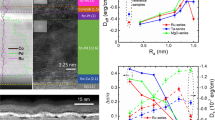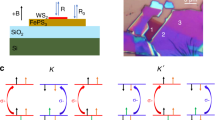Abstract
Characterization and control of the interface structure and morphology at the atomic level is an important issue in understanding the magnetic interaction between an antiferromagnetic material and an adjacent ferromagnet in detail, because the atomic spins in an antiferromagnet change direction on the length scale of nearest atomic distances. Despite its technological importance for the development of advanced magnetic data-storage devices and extensive studies, the details of the magnetic interface coupling between antiferromagnets and ferromagnets have remained concealed. Here we present the results of magneto-optical Kerr-effect measurements and layer-resolved spectro-microscopic magnetic domain imaging of single-crystalline ferromagnet–antiferromagnet– ferromagnet trilayers. Atomic-level control of the interface morphology is achieved by systematically varying the thicknesses of the bottom ferromagnetic and the antiferromagnetic layer. We find that the magnetic coupling across the interface is mediated by step edges of single-atom height, whereas atomically flat areas do not contribute.
This is a preview of subscription content, access via your institution
Access options
Subscribe to this journal
Receive 12 print issues and online access
$259.00 per year
only $21.58 per issue
Buy this article
- Purchase on Springer Link
- Instant access to full article PDF
Prices may be subject to local taxes which are calculated during checkout





Similar content being viewed by others
References
Parkin, S. S. P. et al. Exchange-biased magnetic tunnel junctions and application to nonvolatile magnetic random access memory. J. Appl. Phys. 85, 5828–5833 (1999).
Prinz, G. A. Device physics—magnetoelectronics. Science 282, 1660–1663 (1998).
Wolf, S. A. et al. Spintronics: A spin-based electronics vision for the future. Science 294, 1488–1495 (2001).
Skrumryev, V. et al. Beating the superparamagnetic limit with exchange bias. Nature 423, 850–853 (2003).
Nogués, J. & Schuller, I. K. Exchange bias. J. Magn. Magn. Mater. 192, 203–232 (1999).
Stamps, R. L. Mechanisms for exchange bias. J. Phys. D 33, R247–R268 (2000).
Malozemoff, A. P. Random-field model of exchange anisotropy at rough ferromagnetic-antiferromagnetic interfaces. Phys. Rev. B 35, 3679–3682 (1987).
Offi, F., Kuch, W. & Kirschner, J. Structural and magnetic properties of FexMn1−x thin films on Cu(001) and on Co/Cu(001). Phys. Rev. B 66, 064419 (2002).
Kuch, W., Chelaru, L. I. & Kirschner, J. Surface morphology of antiferromagnetic Fe50Mn50 layers on Cu(001). Surf. Sci. 566–568, 221–225 (2004).
Offi, F. et al. Induced Fe and Mn magnetic moments in Co-FeMn bilayers on Cu(001). Phys. Rev. B 67, 094419 (2003).
Kuch, W. et al. Three-dimensional noncollinear antiferromagnetic order in single-crystalline FeMn ultrathin films. Phys. Rev. Lett. 92, 017201 (2004).
Liu, Z. Y. & Adenwalla, S. Oscillatory interlayer exchange coupling and its temperature dependence in [Pt/Co]3/NiO/[Co/Pt]3 multilayers with perpendicular anisotropy. Phys. Rev. Lett. 91, 037207 (2003).
Kuch, W. et al. Imaging microspectroscopy of Ni/Fe/Co/Cu(001) using a photoemission microscope. J. Electron Spectrosc. Relat. Phenom. 109, 249–265 (2000).
Kuch, W. et al. Magnetic interface coupling in single-crystalline Co/FeMn bilayers. Phys. Rev. B 65, 140408 (2002).
Won, C. et al. Studies of FeMn/Co/Cu(001) films using photoemission electron microscopy and surface magneto-optic Kerr effect. Phys. Rev. B 71, 024406 (2005).
Schmid, A. K. & Kirschner, J. In situ observation of epitaxial growth of Co thin films on Cu(100). Ultramicroscopy 42–44, 483–489 (1992).
Schmid, A. K. et al. Fast interdiffusion in thin films: Scanning-tunneling-microscopy determination of surface diffusion through microscopic pinholes. Phys. Rev. B 48, 2855–2858 (1993).
Umebayashi, H. & Ishikawa, Y. Antiferromagnetism ofγFe-Mn alloys. J. Phys. Soc. Jpn 21, 1281–1294 (1966).
Chikazumi, S. Physics of Ferromagnetism (Oxford Univ. Press, Oxford, 1997).
Sort, J. et al. Perpendicular exchange bias in antiferromagnetic–ferromagnetic nanostructures. Appl. Phys. Lett. 84, 3696–3698 (2004).
Slonczewski, J. C. Fluctuation mechanism for biquadratic exchange coupling in magnetic multilayers. Phys. Rev. Lett. 67, 3172–3175 (1991).
Slonczewski, J. C. Overview of interlayer exchange theory. J. Magn. Magn. Mater. 150, 13–24 (1995).
Morosov, A. I. & Sigov, A. S. New type of domain walls: Domain wall caused by frustrations in multilayer magnetic nanostructures. Phys. Solid State 46, 395–410 (2004).
Takano, K., Kodama, R. H., Berkowitz, A. E., Cao, W. & Thomas, G. Interfacial uncompensated antiferromagnetic spins: Role in unidirectional anisotropy in polycrystalline Ni81Fe19/CoO bilayers. Phys. Rev. Lett. 79, 1130–1133 (1997).
Scholl, A. et al. Domain-size-dependent exchange bias in Co/LaFeO3 . Appl. Phys. Lett. 85, 4085–4087 (2004).
Kuch, W. Layer-resolved microscopy of magnetic domains in multi-layered systems. Appl. Phys. A 76, 665–671 (2003).
Stöhr, J. et al. Element-specific magnetic microscopy with circularly polarized x-rays. Science 259, 658–661 (1993).
Schneider, C. M. & Schönhense, G. Investigating surface magnetism by means of photoexcitation electron emission microscopy. Rep. Prog. Phys. 65, R1785–R1839 (2002).
Kuch, W., Chelaru, L. I., Offi, F., Kotsugi, M. & Kirschner, J. Magnetic dichroisms in absorption and photoemission for magnetic characterization in x-ray photoelectron emission microscopy. J. Vac. Sci. Technol. B 20, 2543–2549 (2002).
Acknowledgements
This work was supported by the German Minister of Science and Education (BMBF) under grant no. 05 KS1EFA6. We thank B. Heinrich, J. T. Kohlhepp, and M. D. Stiles for fruitful discussions.
Author information
Authors and Affiliations
Corresponding author
Ethics declarations
Competing interests
The authors declare no competing financial interests.
Rights and permissions
About this article
Cite this article
Kuch, W., Chelaru, L., Offi, F. et al. Tuning the magnetic coupling across ultrathin antiferromagnetic films by controlling atomic-scale roughness. Nature Mater 5, 128–133 (2006). https://doi.org/10.1038/nmat1548
Received:
Accepted:
Published:
Issue Date:
DOI: https://doi.org/10.1038/nmat1548
This article is cited by
-
Tuning the Néel temperature in an antiferromagnet: the case of NixCo1−xO microstructures
Scientific Reports (2019)
-
Soft X-ray Reflection Spectroscopy for Nano-Scaled Layered Structure Materials
Scientific Reports (2018)
-
Graphene-based synthetic antiferromagnets and ferrimagnets
Nature Communications (2017)
-
Tilt engineering of exchange coupling at G-type SrMnO3/(La,Sr)MnO3 interfaces
Scientific Reports (2015)
-
Engineering the interlayer exchange coupling in magnetic trilayers
Scientific Reports (2015)



